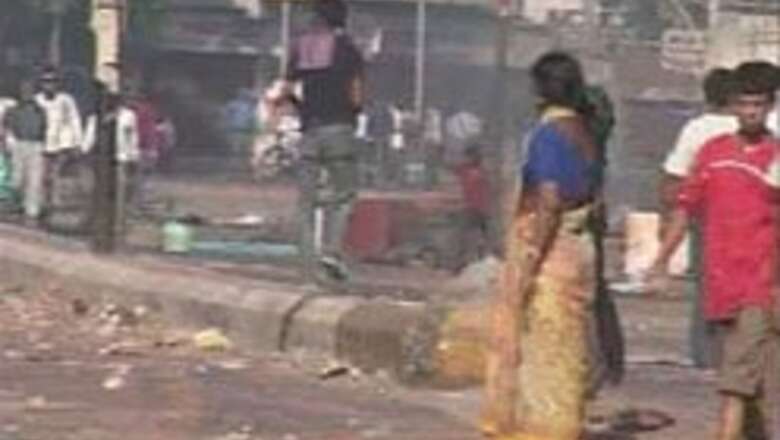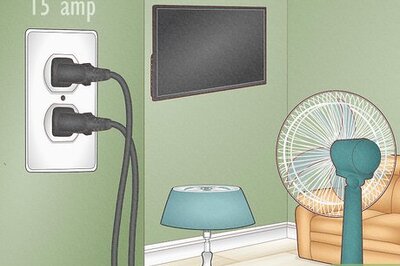
views

Communal and caste violence has acquired endemic proportions in Gujarat during the last three decades. The Ahmedabad-Vadodara belt has been a witness to some of most gruesome instances of violence, claiming hundreds of lives. Here's a lowdown on Vadodara's shaky past.
![]() Communal tensions resurfaced in 1981 and persisted for over a year between September 1981- December 1982. The city went through several bouts of rioting interspersed with moments of uneasy calm.
Communal tensions resurfaced in 1981 and persisted for over a year between September 1981- December 1982. The city went through several bouts of rioting interspersed with moments of uneasy calm. ![]() The beginnings of these riots was attributed to a gradual build of rivalries between groups aspiring to control the thriving illicit liquor trade, culminating in violent conflicts.
The beginnings of these riots was attributed to a gradual build of rivalries between groups aspiring to control the thriving illicit liquor trade, culminating in violent conflicts. ![]() It was not long before what was evidently a conflict of interest took a violent communal turn. On September 11, 1981 a rumour had spread out from the Hindu dominated Ladwada area purporting desecration of a Ganesh idol by a Muslim child.
It was not long before what was evidently a conflict of interest took a violent communal turn. On September 11, 1981 a rumour had spread out from the Hindu dominated Ladwada area purporting desecration of a Ganesh idol by a Muslim child. ![]() Some 18 incidents of communal rioting were recorded in the city between September 1981 and December 1982.
Some 18 incidents of communal rioting were recorded in the city between September 1981 and December 1982. ![]() Extensive burning and looting of houses and shops followed thereafter. The worst instance, however, occurred on 13 December 1982 that involved the participation of middle class youth in the violence, indicating a change in the composition of the rioters.
Extensive burning and looting of houses and shops followed thereafter. The worst instance, however, occurred on 13 December 1982 that involved the participation of middle class youth in the violence, indicating a change in the composition of the rioters. ![]() The pattern changed in 80s and social conflicts, principally over the issue of reservation quotas for backward castes and communities and the reactive political mobilisation of the upper castes deeply hostile to reservation as an idea.
The pattern changed in 80s and social conflicts, principally over the issue of reservation quotas for backward castes and communities and the reactive political mobilisation of the upper castes deeply hostile to reservation as an idea. ![]() The trend first came into view with the communal disturbances of 1981-82. The anti-reservation stir of 1985 in Gujarat and the communal riots that followed it, stabilised the trend.
The trend first came into view with the communal disturbances of 1981-82. The anti-reservation stir of 1985 in Gujarat and the communal riots that followed it, stabilised the trend. ![]() On March 18, 1982, the mrthuya ghant, literally the death knell, of the reservation policy was sounded in Ahmedabad. It had its disastrous side-effects in many towns and cities of Gujarat.
On March 18, 1982, the mrthuya ghant, literally the death knell, of the reservation policy was sounded in Ahmedabad. It had its disastrous side-effects in many towns and cities of Gujarat.
The 1990s
Violence of 2002 ![]() The Best Bakery case is among the most serious instances of violence during the Gujarat carnage of 2002.
The Best Bakery case is among the most serious instances of violence during the Gujarat carnage of 2002. ![]() On March 1, 2002, a mob in Vadodra (erstwhile Barodra), Gujarat, the ignominious Best Bakery massacre took place as nearly 1000 rioters swooped on the bakery-cum-residence owned by late Habibullah Sheikh at 2100 hours IST and within a matter of hours eleven members of the Sheikh family and three bakery employees were either charred to death or hacked to pieces. Best Bakery case: A flashback
On March 1, 2002, a mob in Vadodra (erstwhile Barodra), Gujarat, the ignominious Best Bakery massacre took place as nearly 1000 rioters swooped on the bakery-cum-residence owned by late Habibullah Sheikh at 2100 hours IST and within a matter of hours eleven members of the Sheikh family and three bakery employees were either charred to death or hacked to pieces. Best Bakery case: A flashback













Comments
0 comment